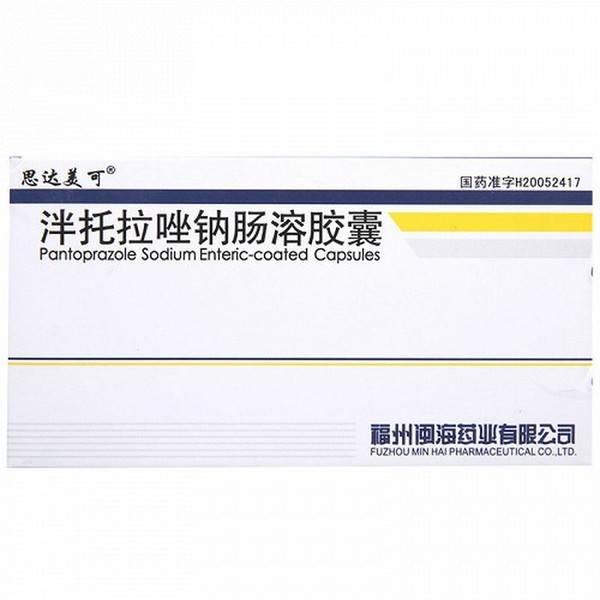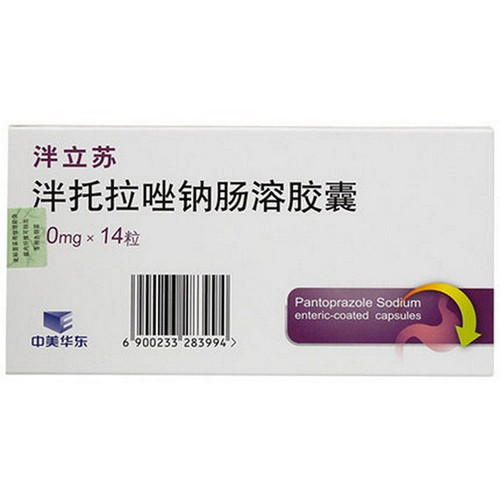Product Overview
[Drug Name]
Trade Name: Sidameike
English Name: Pantoprazole Sodium Enteric-coated Capsules
[Ingredients]
The main ingredient of this product is pantoprazole sodium. Chemical Name: 5-difluoromethoxy-2-[[(3,4-dimethoxy-2-pyridyl)methyl]-sulfinyl}-1H-benzimidazole sodium monohydrate.
[Properties]
This product contains enteric-coated film-coated microcapsules, which are white after removal of the film coating.
[Indications]
Primarily used for: 1. Peptic ulcer bleeding. 2. Acute gastric mucosal damage caused by nonsteroidal anti-inflammatory drugs and ulcer bleeding under stress; 3. Prevention of gastric acid reflux and aspiration pneumonia after general anesthesia or major surgery, as well as in debilitated and comatose patients.
[Dosage and Administration]
This product should be taken under the guidance of a physician according to the following dosage. Take one capsule orally daily before breakfast. The typical course of treatment for duodenal ulcers is 2-4 weeks, while for gastric ulcers and reflux esophagitis, it is typically 4 weeks. Continue taking the drug as needed. Individual variability is minimal, and dosage adjustment is not required for elderly patients.
[Adverse Reactions]
Occasional symptoms include dizziness, insomnia, drowsiness, nausea, diarrhea, constipation, rash, and muscle pain. High doses may cause arrhythmias, elevated aminotransferases, changes in renal function, and decreased granulocyte counts.
[Contraindications]
This drug is contraindicated in patients with allergies. It is also contraindicated in pregnant and lactating women.
[Precautions]
1. This drug has a strong and long-lasting inhibitory effect on gastric acid secretion. Therefore, it should not be taken concurrently with other antacids or acid suppressants. To prevent excessive acid suppression, long-term high-dose use is not recommended for general conditions such as peptic ulcers (except for Zollinger-Ellison syndrome). 2. No dose adjustment is required for patients with impaired renal function; a dose reduction may be appropriate for patients with impaired liver function. 3. This drug should only be used to treat gastric ulcers after gastric cancer has been ruled out to avoid delays in diagnosis and treatment. 4. In animal studies, long-term, high-dose use of this drug has been associated with hypergastrinemia and the development of secondary gastric ECL cell enlargement and benign tumors. These changes can also occur with the use of other acid suppressants and after subtotal gastrectomy.
[Use in Special Populations]
Precautions for Pediatric Use: Efficacy and safety data for this drug in children have not been established. This drug is contraindicated in infants and young children.
Precautions for Pregnancy and Lactation: This drug is contraindicated in pregnant and lactating women.
Precautions for Elderly Patients: No dose adjustment is required.
[Drug Interactions]
Not yet known.
[Pharmacological Action]
This drug is a proton pump inhibitor of gastric parietal cells. It is relatively stable under neutral and weakly acidic conditions and rapidly activated under strongly acidic conditions. Its pH-dependent activation properties make it highly selective for H+ and K+-ATPases. This drug specifically inhibits H+ and K+-ATPases located in the secretory microtubules and tubulo-vacuoles of the apical membrane of parietal cells, causing irreversible inhibition of these enzymes and thereby effectively suppressing gastric acid secretion. Because H+ and K+-ATPases are the final step in the acid secretion process of parietal cells, this drug has a strong acid-suppressing effect. It not only non-competitively inhibits gastric acid secretion induced by gastrin, histamine, and choline, but also inhibits basal gastric acid secretion that is not affected by cholinergics or H2 receptor blockers. This drug has the advantage of minimal drug-drug interactions when used in combination with other drugs. This drug is metabolized by system I of the cytochrome P450 enzyme system in hepatocytes, but can also be metabolized by system II. When used with other drugs metabolized by the P450 enzyme system, this product is metabolized through the P450 enzyme system, making it less likely to compete with drug-metabolizing enzymes and reducing drug-drug interactions in the body. It is non-mutagenic, carcinogenic, or teratogenic.
[Storage]
Store tightly closed.
[Specifications]
20 mg
[Packaging]
20 mg x 8 sachets/box
[Expiry Date]
24 months
[Approval Number]
National Medicine Standard No. H20052417
[Manufacturer]
Company Name: Fuzhou Minhai Pharmaceutical Co., Ltd.








